HA2032: Corporate and Financial Accounting: Funds and Entity Analysis
VerifiedAdded on 2022/10/17
|12
|3269
|193
Report
AI Summary
This report provides a comprehensive analysis of corporate and financial accounting, examining the various sources of funds that companies utilize. The report delves into the specifics of owner's equity, including contributed equity, retained earnings, and reserves, and tracks the movement of these items over a three-year period for both Woolworths and Wesfarmers. It also investigates the liabilities section, covering borrowings, tax payable, trade payable, and provisions, with an analysis of the changes in these items. Furthermore, the report explores the merits and demerits of different funding sources. Finally, the report discusses the classification of companies into large and small proprietary entities and the implications of such classifications, including compliance and reporting requirements. The analysis provides insights into financial management practices and the impact of funding decisions on company performance.
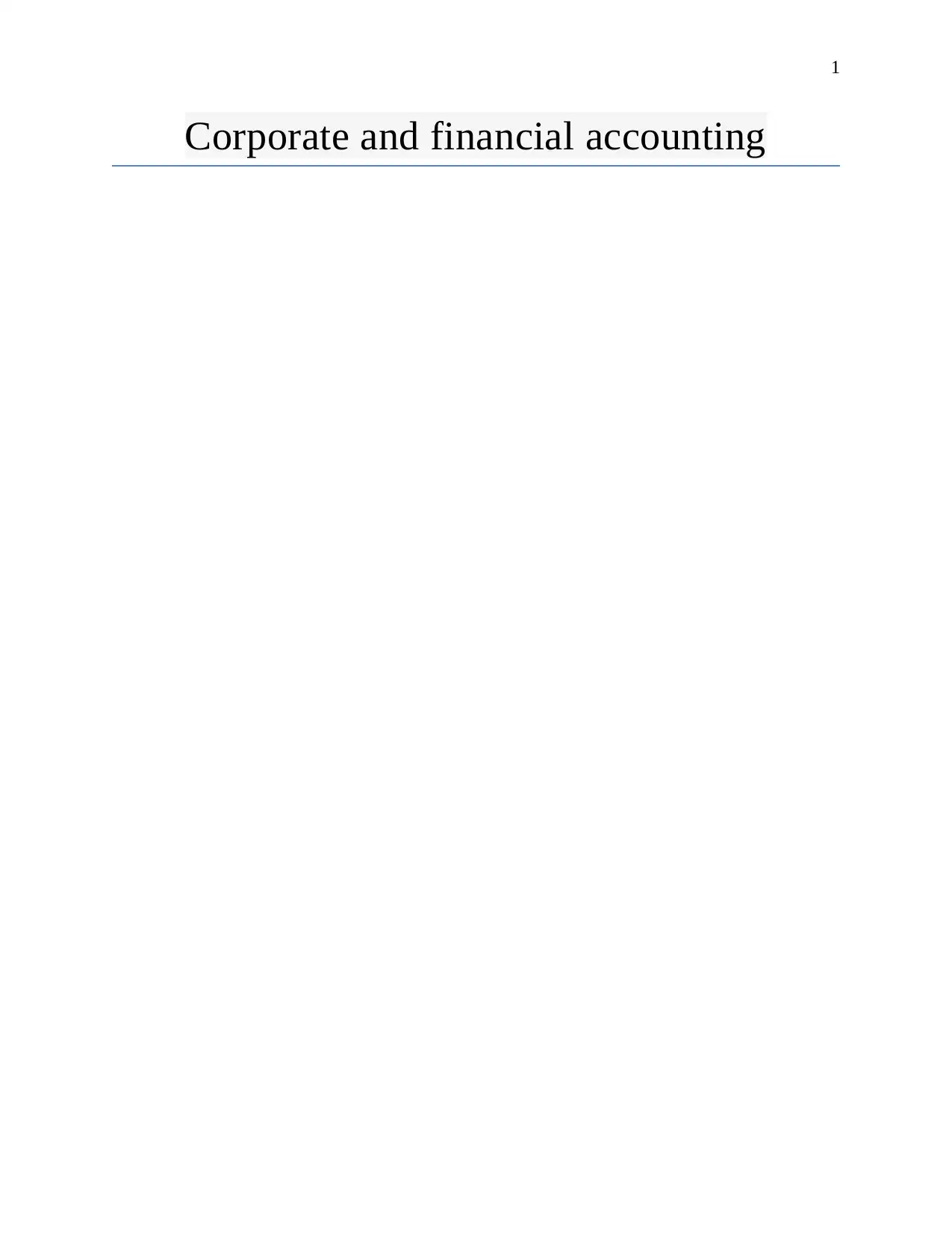
1
Corporate and financial accounting
Corporate and financial accounting
Paraphrase This Document
Need a fresh take? Get an instant paraphrase of this document with our AI Paraphraser
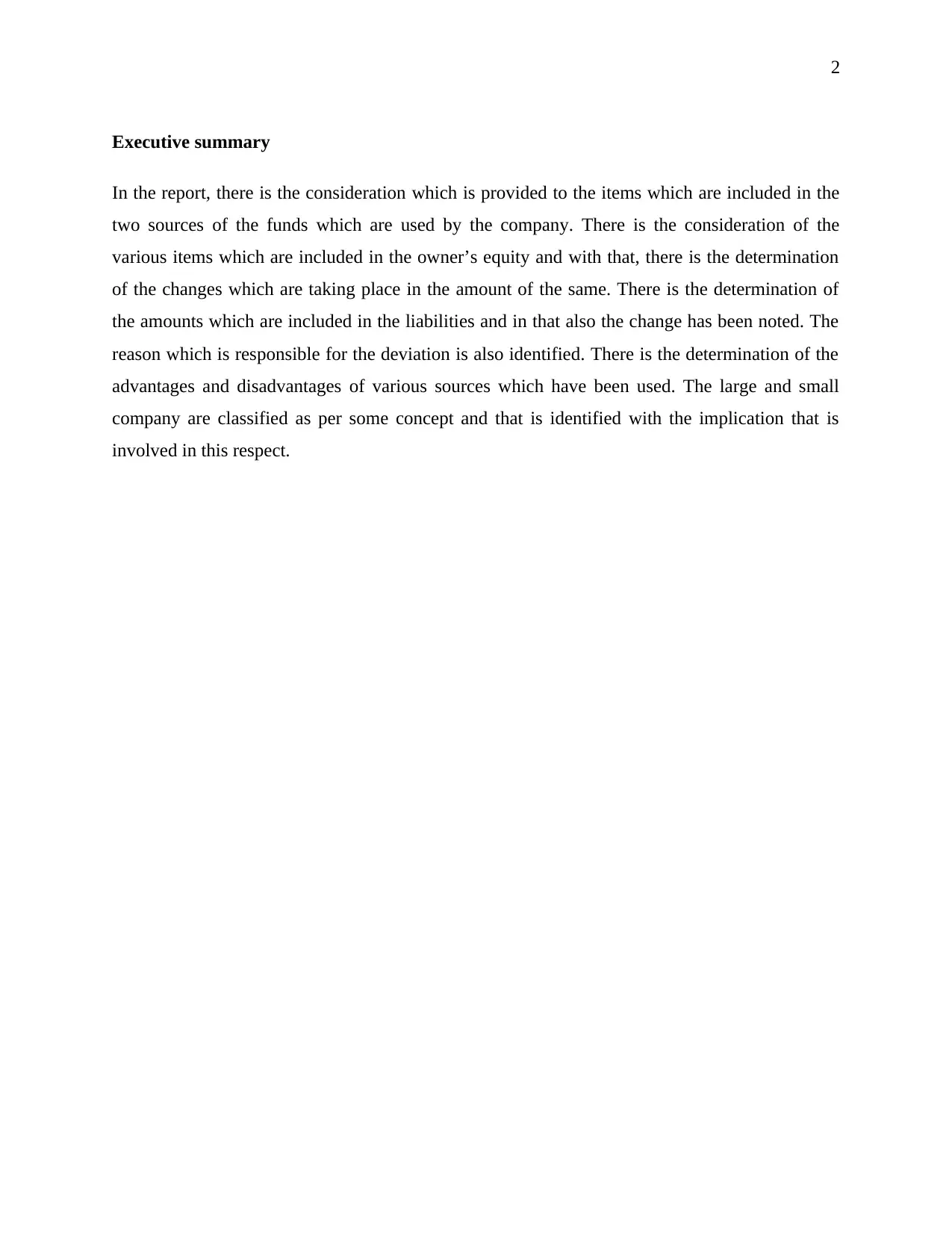
2
Executive summary
In the report, there is the consideration which is provided to the items which are included in the
two sources of the funds which are used by the company. There is the consideration of the
various items which are included in the owner’s equity and with that, there is the determination
of the changes which are taking place in the amount of the same. There is the determination of
the amounts which are included in the liabilities and in that also the change has been noted. The
reason which is responsible for the deviation is also identified. There is the determination of the
advantages and disadvantages of various sources which have been used. The large and small
company are classified as per some concept and that is identified with the implication that is
involved in this respect.
Executive summary
In the report, there is the consideration which is provided to the items which are included in the
two sources of the funds which are used by the company. There is the consideration of the
various items which are included in the owner’s equity and with that, there is the determination
of the changes which are taking place in the amount of the same. There is the determination of
the amounts which are included in the liabilities and in that also the change has been noted. The
reason which is responsible for the deviation is also identified. There is the determination of the
advantages and disadvantages of various sources which have been used. The large and small
company are classified as per some concept and that is identified with the implication that is
involved in this respect.
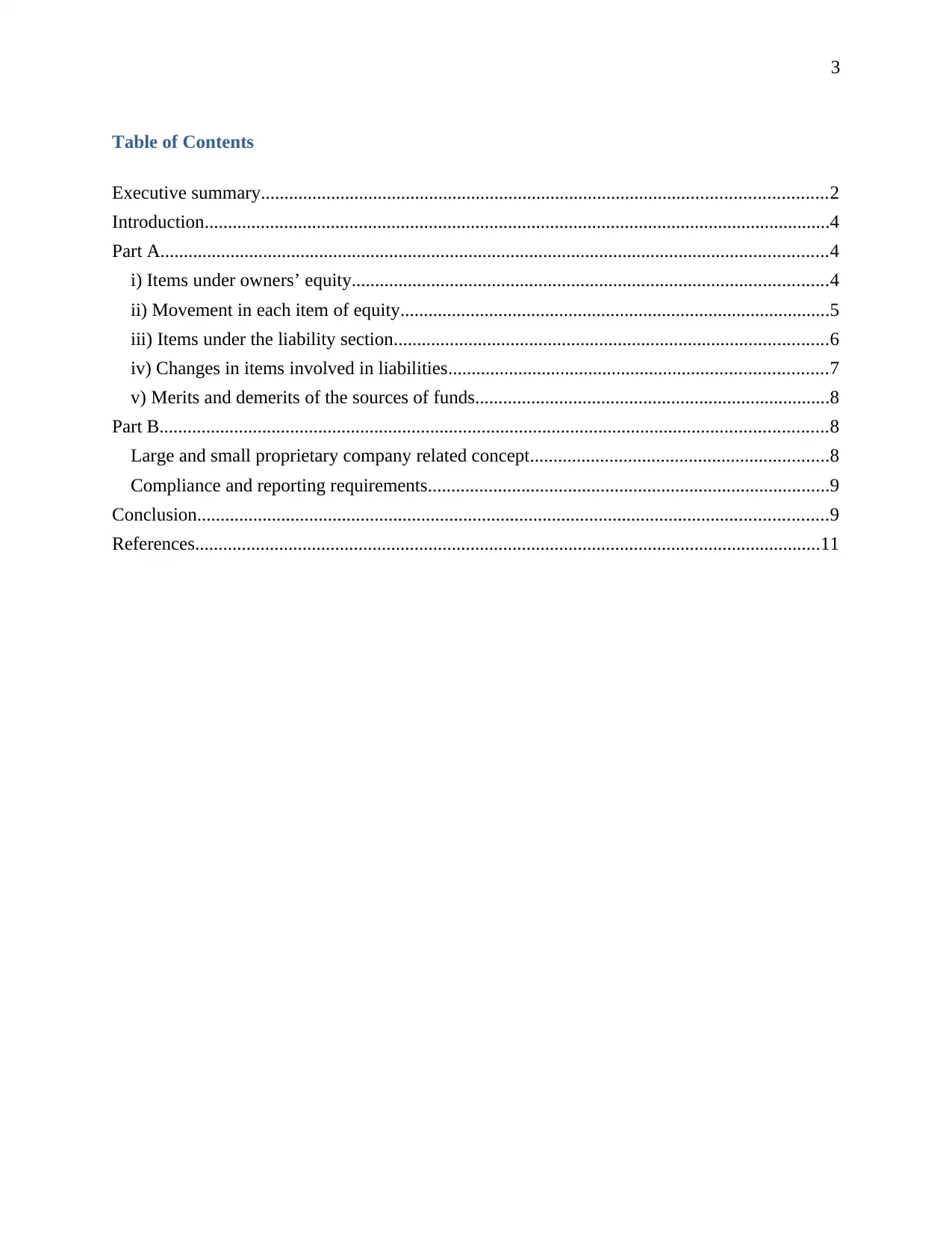
3
Table of Contents
Executive summary.........................................................................................................................2
Introduction......................................................................................................................................4
Part A...............................................................................................................................................4
i) Items under owners’ equity......................................................................................................4
ii) Movement in each item of equity............................................................................................5
iii) Items under the liability section.............................................................................................6
iv) Changes in items involved in liabilities.................................................................................7
v) Merits and demerits of the sources of funds............................................................................8
Part B...............................................................................................................................................8
Large and small proprietary company related concept................................................................8
Compliance and reporting requirements......................................................................................9
Conclusion.......................................................................................................................................9
References......................................................................................................................................11
Table of Contents
Executive summary.........................................................................................................................2
Introduction......................................................................................................................................4
Part A...............................................................................................................................................4
i) Items under owners’ equity......................................................................................................4
ii) Movement in each item of equity............................................................................................5
iii) Items under the liability section.............................................................................................6
iv) Changes in items involved in liabilities.................................................................................7
v) Merits and demerits of the sources of funds............................................................................8
Part B...............................................................................................................................................8
Large and small proprietary company related concept................................................................8
Compliance and reporting requirements......................................................................................9
Conclusion.......................................................................................................................................9
References......................................................................................................................................11
⊘ This is a preview!⊘
Do you want full access?
Subscribe today to unlock all pages.

Trusted by 1+ million students worldwide
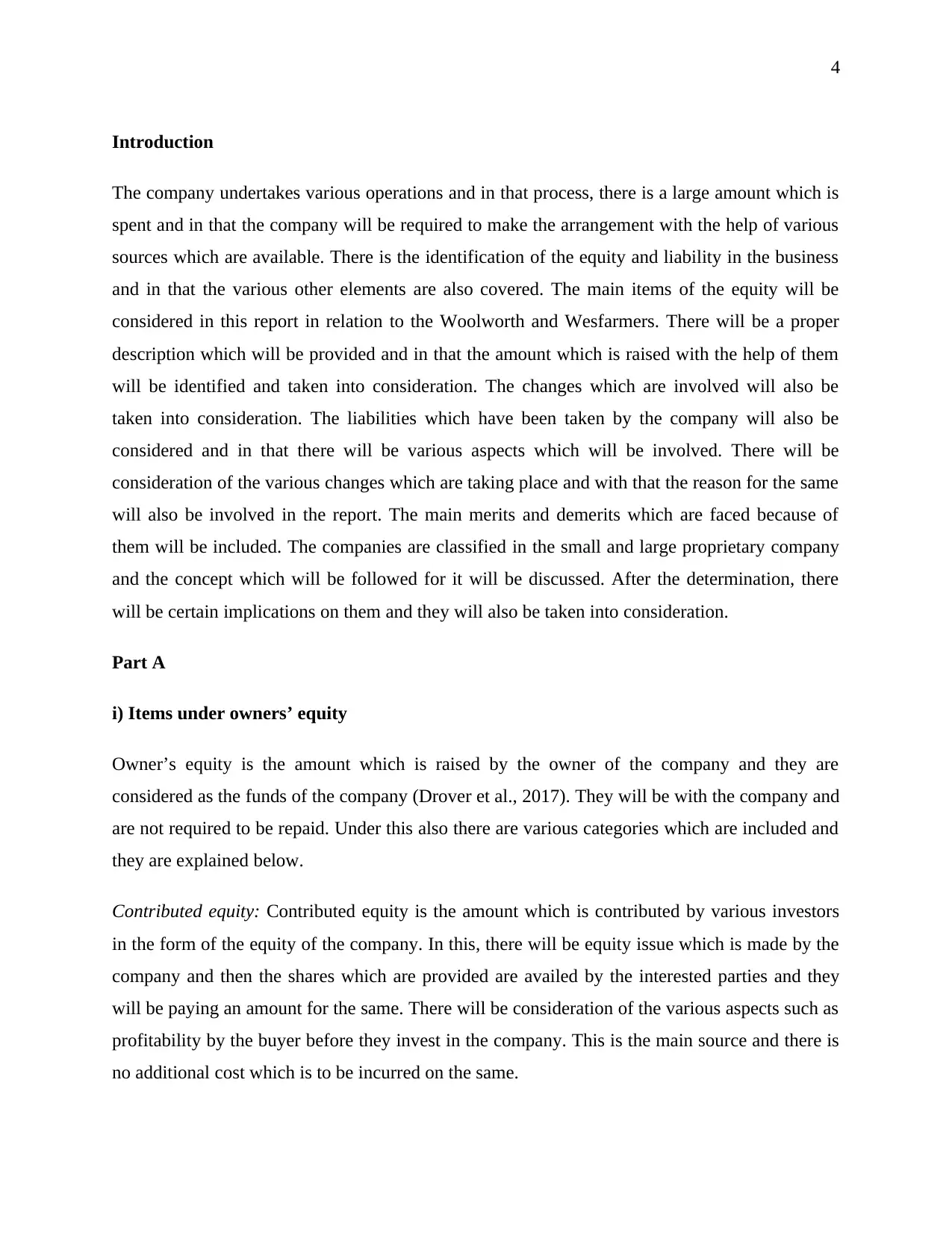
4
Introduction
The company undertakes various operations and in that process, there is a large amount which is
spent and in that the company will be required to make the arrangement with the help of various
sources which are available. There is the identification of the equity and liability in the business
and in that the various other elements are also covered. The main items of the equity will be
considered in this report in relation to the Woolworth and Wesfarmers. There will be a proper
description which will be provided and in that the amount which is raised with the help of them
will be identified and taken into consideration. The changes which are involved will also be
taken into consideration. The liabilities which have been taken by the company will also be
considered and in that there will be various aspects which will be involved. There will be
consideration of the various changes which are taking place and with that the reason for the same
will also be involved in the report. The main merits and demerits which are faced because of
them will be included. The companies are classified in the small and large proprietary company
and the concept which will be followed for it will be discussed. After the determination, there
will be certain implications on them and they will also be taken into consideration.
Part A
i) Items under owners’ equity
Owner’s equity is the amount which is raised by the owner of the company and they are
considered as the funds of the company (Drover et al., 2017). They will be with the company and
are not required to be repaid. Under this also there are various categories which are included and
they are explained below.
Contributed equity: Contributed equity is the amount which is contributed by various investors
in the form of the equity of the company. In this, there will be equity issue which is made by the
company and then the shares which are provided are availed by the interested parties and they
will be paying an amount for the same. There will be consideration of the various aspects such as
profitability by the buyer before they invest in the company. This is the main source and there is
no additional cost which is to be incurred on the same.
Introduction
The company undertakes various operations and in that process, there is a large amount which is
spent and in that the company will be required to make the arrangement with the help of various
sources which are available. There is the identification of the equity and liability in the business
and in that the various other elements are also covered. The main items of the equity will be
considered in this report in relation to the Woolworth and Wesfarmers. There will be a proper
description which will be provided and in that the amount which is raised with the help of them
will be identified and taken into consideration. The changes which are involved will also be
taken into consideration. The liabilities which have been taken by the company will also be
considered and in that there will be various aspects which will be involved. There will be
consideration of the various changes which are taking place and with that the reason for the same
will also be involved in the report. The main merits and demerits which are faced because of
them will be included. The companies are classified in the small and large proprietary company
and the concept which will be followed for it will be discussed. After the determination, there
will be certain implications on them and they will also be taken into consideration.
Part A
i) Items under owners’ equity
Owner’s equity is the amount which is raised by the owner of the company and they are
considered as the funds of the company (Drover et al., 2017). They will be with the company and
are not required to be repaid. Under this also there are various categories which are included and
they are explained below.
Contributed equity: Contributed equity is the amount which is contributed by various investors
in the form of the equity of the company. In this, there will be equity issue which is made by the
company and then the shares which are provided are availed by the interested parties and they
will be paying an amount for the same. There will be consideration of the various aspects such as
profitability by the buyer before they invest in the company. This is the main source and there is
no additional cost which is to be incurred on the same.
Paraphrase This Document
Need a fresh take? Get an instant paraphrase of this document with our AI Paraphraser
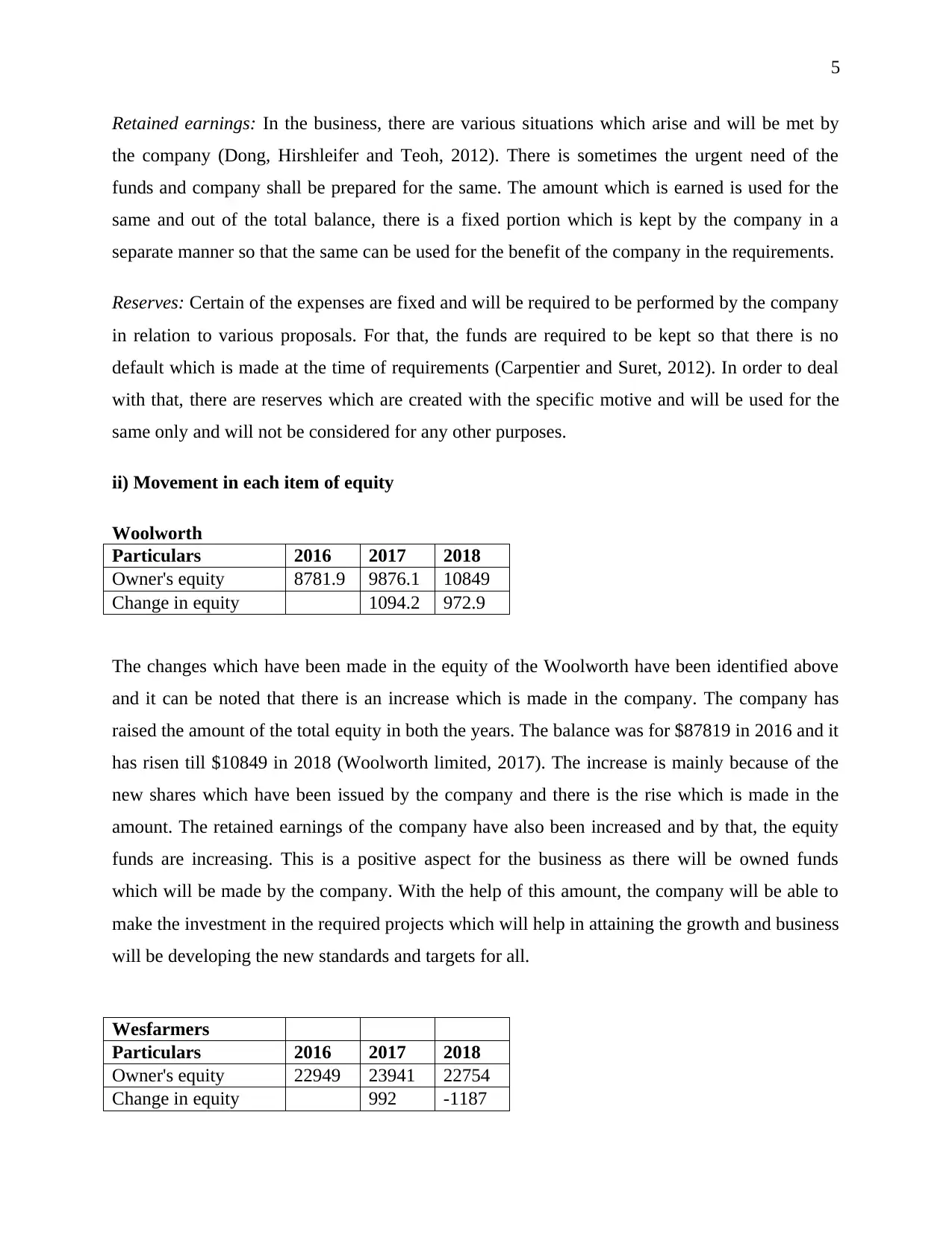
5
Retained earnings: In the business, there are various situations which arise and will be met by
the company (Dong, Hirshleifer and Teoh, 2012). There is sometimes the urgent need of the
funds and company shall be prepared for the same. The amount which is earned is used for the
same and out of the total balance, there is a fixed portion which is kept by the company in a
separate manner so that the same can be used for the benefit of the company in the requirements.
Reserves: Certain of the expenses are fixed and will be required to be performed by the company
in relation to various proposals. For that, the funds are required to be kept so that there is no
default which is made at the time of requirements (Carpentier and Suret, 2012). In order to deal
with that, there are reserves which are created with the specific motive and will be used for the
same only and will not be considered for any other purposes.
ii) Movement in each item of equity
Woolworth
Particulars 2016 2017 2018
Owner's equity 8781.9 9876.1 10849
Change in equity 1094.2 972.9
The changes which have been made in the equity of the Woolworth have been identified above
and it can be noted that there is an increase which is made in the company. The company has
raised the amount of the total equity in both the years. The balance was for $87819 in 2016 and it
has risen till $10849 in 2018 (Woolworth limited, 2017). The increase is mainly because of the
new shares which have been issued by the company and there is the rise which is made in the
amount. The retained earnings of the company have also been increased and by that, the equity
funds are increasing. This is a positive aspect for the business as there will be owned funds
which will be made by the company. With the help of this amount, the company will be able to
make the investment in the required projects which will help in attaining the growth and business
will be developing the new standards and targets for all.
Wesfarmers
Particulars 2016 2017 2018
Owner's equity 22949 23941 22754
Change in equity 992 -1187
Retained earnings: In the business, there are various situations which arise and will be met by
the company (Dong, Hirshleifer and Teoh, 2012). There is sometimes the urgent need of the
funds and company shall be prepared for the same. The amount which is earned is used for the
same and out of the total balance, there is a fixed portion which is kept by the company in a
separate manner so that the same can be used for the benefit of the company in the requirements.
Reserves: Certain of the expenses are fixed and will be required to be performed by the company
in relation to various proposals. For that, the funds are required to be kept so that there is no
default which is made at the time of requirements (Carpentier and Suret, 2012). In order to deal
with that, there are reserves which are created with the specific motive and will be used for the
same only and will not be considered for any other purposes.
ii) Movement in each item of equity
Woolworth
Particulars 2016 2017 2018
Owner's equity 8781.9 9876.1 10849
Change in equity 1094.2 972.9
The changes which have been made in the equity of the Woolworth have been identified above
and it can be noted that there is an increase which is made in the company. The company has
raised the amount of the total equity in both the years. The balance was for $87819 in 2016 and it
has risen till $10849 in 2018 (Woolworth limited, 2017). The increase is mainly because of the
new shares which have been issued by the company and there is the rise which is made in the
amount. The retained earnings of the company have also been increased and by that, the equity
funds are increasing. This is a positive aspect for the business as there will be owned funds
which will be made by the company. With the help of this amount, the company will be able to
make the investment in the required projects which will help in attaining the growth and business
will be developing the new standards and targets for all.
Wesfarmers
Particulars 2016 2017 2018
Owner's equity 22949 23941 22754
Change in equity 992 -1187
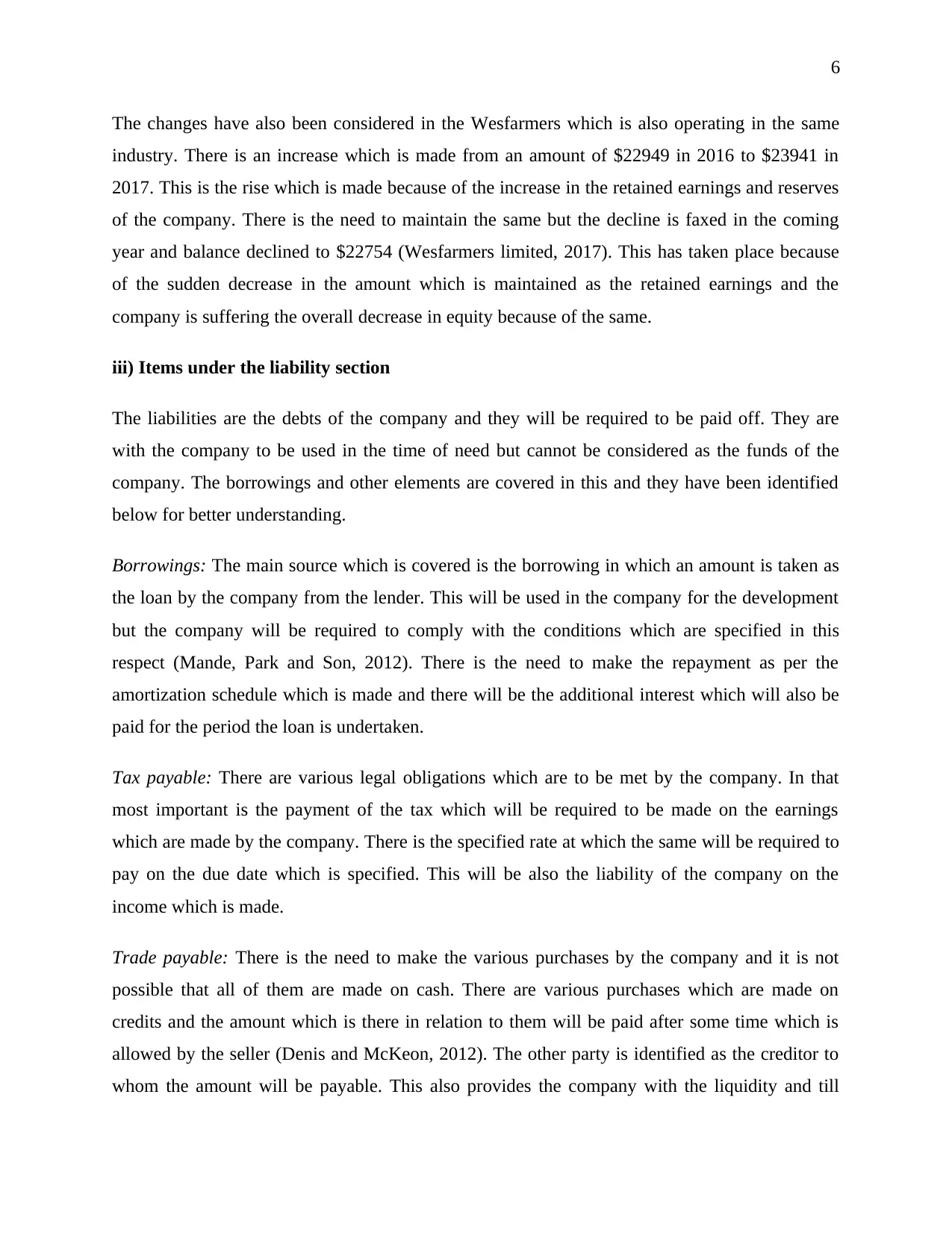
6
The changes have also been considered in the Wesfarmers which is also operating in the same
industry. There is an increase which is made from an amount of $22949 in 2016 to $23941 in
2017. This is the rise which is made because of the increase in the retained earnings and reserves
of the company. There is the need to maintain the same but the decline is faxed in the coming
year and balance declined to $22754 (Wesfarmers limited, 2017). This has taken place because
of the sudden decrease in the amount which is maintained as the retained earnings and the
company is suffering the overall decrease in equity because of the same.
iii) Items under the liability section
The liabilities are the debts of the company and they will be required to be paid off. They are
with the company to be used in the time of need but cannot be considered as the funds of the
company. The borrowings and other elements are covered in this and they have been identified
below for better understanding.
Borrowings: The main source which is covered is the borrowing in which an amount is taken as
the loan by the company from the lender. This will be used in the company for the development
but the company will be required to comply with the conditions which are specified in this
respect (Mande, Park and Son, 2012). There is the need to make the repayment as per the
amortization schedule which is made and there will be the additional interest which will also be
paid for the period the loan is undertaken.
Tax payable: There are various legal obligations which are to be met by the company. In that
most important is the payment of the tax which will be required to be made on the earnings
which are made by the company. There is the specified rate at which the same will be required to
pay on the due date which is specified. This will be also the liability of the company on the
income which is made.
Trade payable: There is the need to make the various purchases by the company and it is not
possible that all of them are made on cash. There are various purchases which are made on
credits and the amount which is there in relation to them will be paid after some time which is
allowed by the seller (Denis and McKeon, 2012). The other party is identified as the creditor to
whom the amount will be payable. This also provides the company with the liquidity and till
The changes have also been considered in the Wesfarmers which is also operating in the same
industry. There is an increase which is made from an amount of $22949 in 2016 to $23941 in
2017. This is the rise which is made because of the increase in the retained earnings and reserves
of the company. There is the need to maintain the same but the decline is faxed in the coming
year and balance declined to $22754 (Wesfarmers limited, 2017). This has taken place because
of the sudden decrease in the amount which is maintained as the retained earnings and the
company is suffering the overall decrease in equity because of the same.
iii) Items under the liability section
The liabilities are the debts of the company and they will be required to be paid off. They are
with the company to be used in the time of need but cannot be considered as the funds of the
company. The borrowings and other elements are covered in this and they have been identified
below for better understanding.
Borrowings: The main source which is covered is the borrowing in which an amount is taken as
the loan by the company from the lender. This will be used in the company for the development
but the company will be required to comply with the conditions which are specified in this
respect (Mande, Park and Son, 2012). There is the need to make the repayment as per the
amortization schedule which is made and there will be the additional interest which will also be
paid for the period the loan is undertaken.
Tax payable: There are various legal obligations which are to be met by the company. In that
most important is the payment of the tax which will be required to be made on the earnings
which are made by the company. There is the specified rate at which the same will be required to
pay on the due date which is specified. This will be also the liability of the company on the
income which is made.
Trade payable: There is the need to make the various purchases by the company and it is not
possible that all of them are made on cash. There are various purchases which are made on
credits and the amount which is there in relation to them will be paid after some time which is
allowed by the seller (Denis and McKeon, 2012). The other party is identified as the creditor to
whom the amount will be payable. This also provides the company with the liquidity and till
⊘ This is a preview!⊘
Do you want full access?
Subscribe today to unlock all pages.

Trusted by 1+ million students worldwide
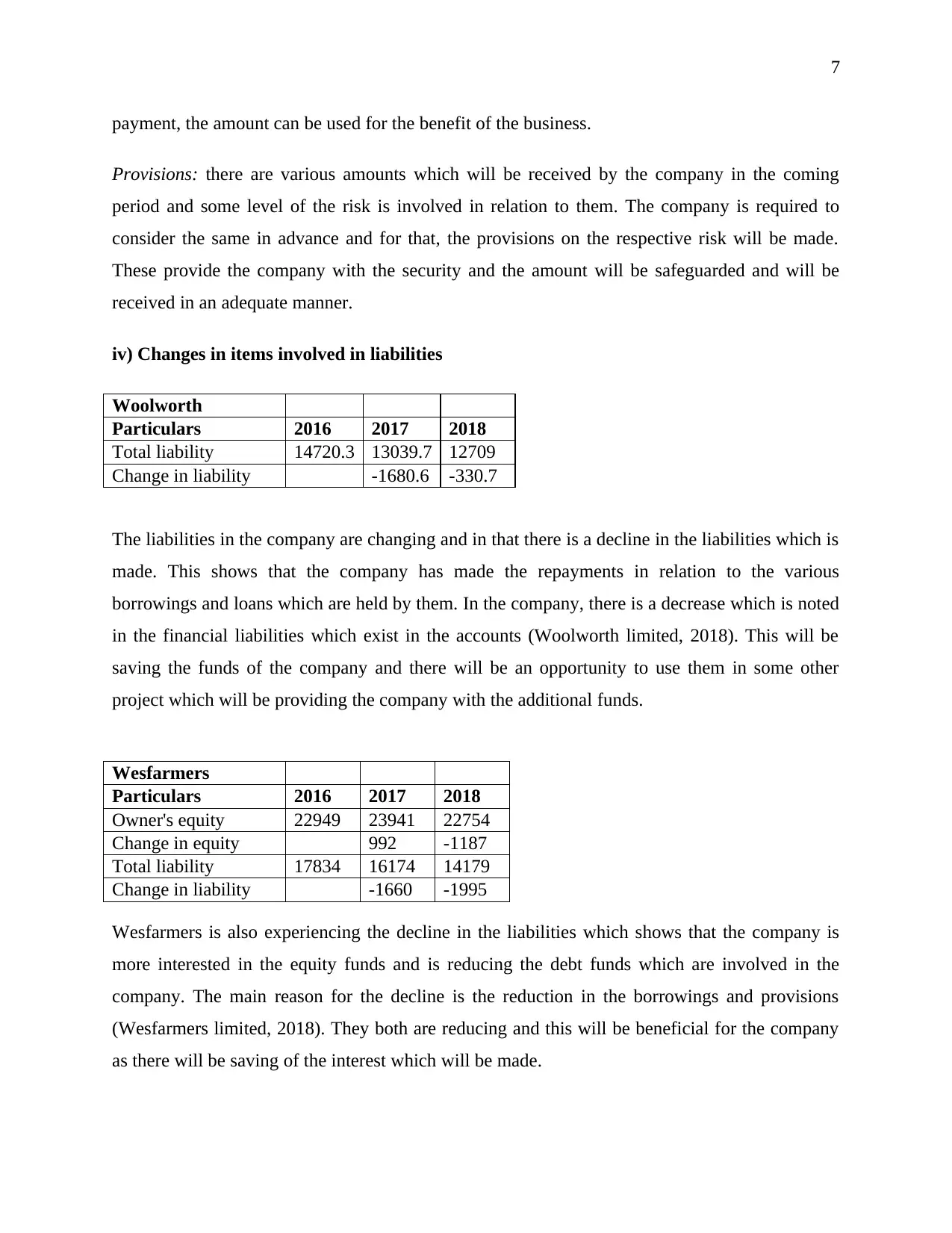
7
payment, the amount can be used for the benefit of the business.
Provisions: there are various amounts which will be received by the company in the coming
period and some level of the risk is involved in relation to them. The company is required to
consider the same in advance and for that, the provisions on the respective risk will be made.
These provide the company with the security and the amount will be safeguarded and will be
received in an adequate manner.
iv) Changes in items involved in liabilities
Woolworth
Particulars 2016 2017 2018
Total liability 14720.3 13039.7 12709
Change in liability -1680.6 -330.7
The liabilities in the company are changing and in that there is a decline in the liabilities which is
made. This shows that the company has made the repayments in relation to the various
borrowings and loans which are held by them. In the company, there is a decrease which is noted
in the financial liabilities which exist in the accounts (Woolworth limited, 2018). This will be
saving the funds of the company and there will be an opportunity to use them in some other
project which will be providing the company with the additional funds.
Wesfarmers
Particulars 2016 2017 2018
Owner's equity 22949 23941 22754
Change in equity 992 -1187
Total liability 17834 16174 14179
Change in liability -1660 -1995
Wesfarmers is also experiencing the decline in the liabilities which shows that the company is
more interested in the equity funds and is reducing the debt funds which are involved in the
company. The main reason for the decline is the reduction in the borrowings and provisions
(Wesfarmers limited, 2018). They both are reducing and this will be beneficial for the company
as there will be saving of the interest which will be made.
payment, the amount can be used for the benefit of the business.
Provisions: there are various amounts which will be received by the company in the coming
period and some level of the risk is involved in relation to them. The company is required to
consider the same in advance and for that, the provisions on the respective risk will be made.
These provide the company with the security and the amount will be safeguarded and will be
received in an adequate manner.
iv) Changes in items involved in liabilities
Woolworth
Particulars 2016 2017 2018
Total liability 14720.3 13039.7 12709
Change in liability -1680.6 -330.7
The liabilities in the company are changing and in that there is a decline in the liabilities which is
made. This shows that the company has made the repayments in relation to the various
borrowings and loans which are held by them. In the company, there is a decrease which is noted
in the financial liabilities which exist in the accounts (Woolworth limited, 2018). This will be
saving the funds of the company and there will be an opportunity to use them in some other
project which will be providing the company with the additional funds.
Wesfarmers
Particulars 2016 2017 2018
Owner's equity 22949 23941 22754
Change in equity 992 -1187
Total liability 17834 16174 14179
Change in liability -1660 -1995
Wesfarmers is also experiencing the decline in the liabilities which shows that the company is
more interested in the equity funds and is reducing the debt funds which are involved in the
company. The main reason for the decline is the reduction in the borrowings and provisions
(Wesfarmers limited, 2018). They both are reducing and this will be beneficial for the company
as there will be saving of the interest which will be made.
Paraphrase This Document
Need a fresh take? Get an instant paraphrase of this document with our AI Paraphraser
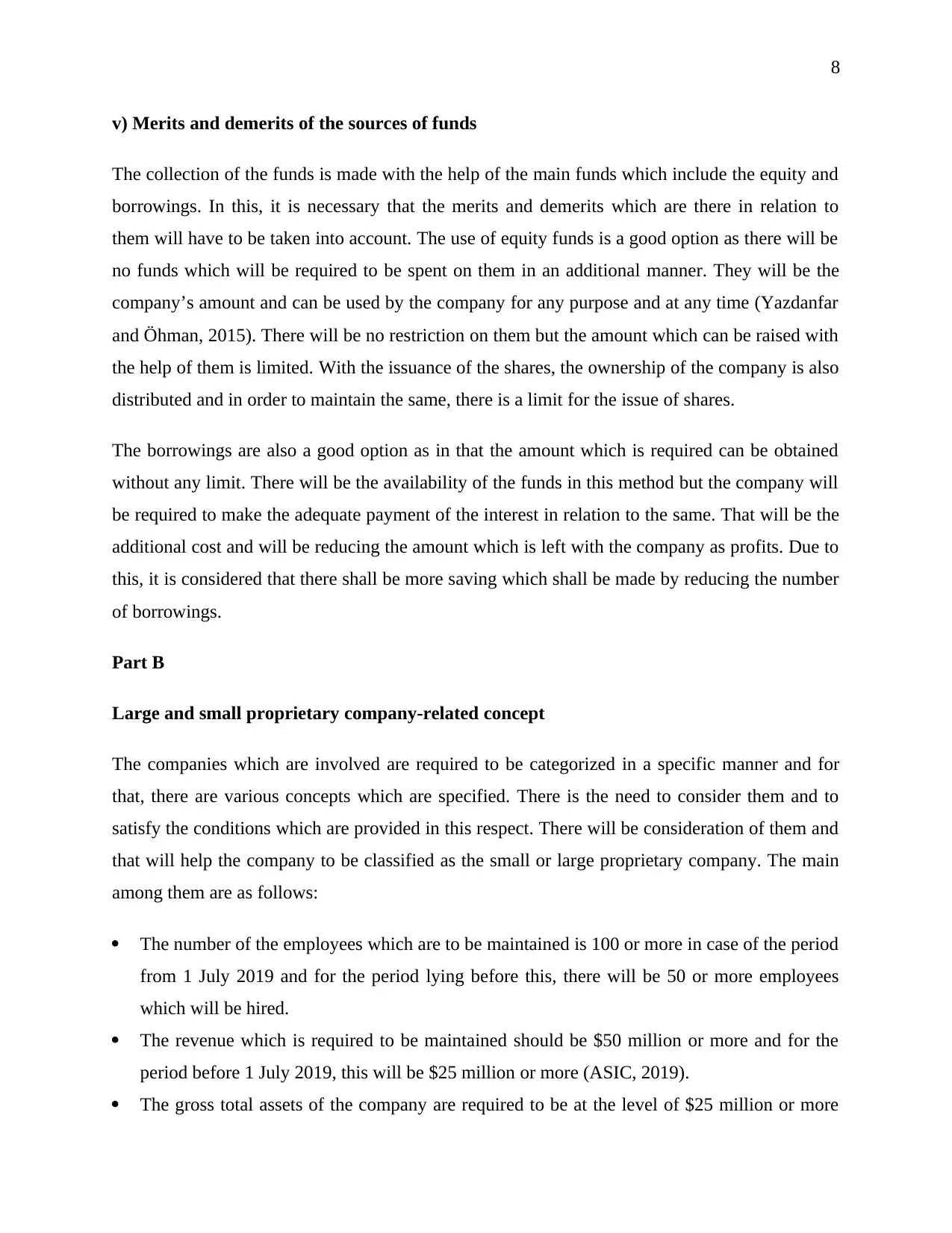
8
v) Merits and demerits of the sources of funds
The collection of the funds is made with the help of the main funds which include the equity and
borrowings. In this, it is necessary that the merits and demerits which are there in relation to
them will have to be taken into account. The use of equity funds is a good option as there will be
no funds which will be required to be spent on them in an additional manner. They will be the
company’s amount and can be used by the company for any purpose and at any time (Yazdanfar
and Öhman, 2015). There will be no restriction on them but the amount which can be raised with
the help of them is limited. With the issuance of the shares, the ownership of the company is also
distributed and in order to maintain the same, there is a limit for the issue of shares.
The borrowings are also a good option as in that the amount which is required can be obtained
without any limit. There will be the availability of the funds in this method but the company will
be required to make the adequate payment of the interest in relation to the same. That will be the
additional cost and will be reducing the amount which is left with the company as profits. Due to
this, it is considered that there shall be more saving which shall be made by reducing the number
of borrowings.
Part B
Large and small proprietary company-related concept
The companies which are involved are required to be categorized in a specific manner and for
that, there are various concepts which are specified. There is the need to consider them and to
satisfy the conditions which are provided in this respect. There will be consideration of them and
that will help the company to be classified as the small or large proprietary company. The main
among them are as follows:
The number of the employees which are to be maintained is 100 or more in case of the period
from 1 July 2019 and for the period lying before this, there will be 50 or more employees
which will be hired.
The revenue which is required to be maintained should be $50 million or more and for the
period before 1 July 2019, this will be $25 million or more (ASIC, 2019).
The gross total assets of the company are required to be at the level of $25 million or more
v) Merits and demerits of the sources of funds
The collection of the funds is made with the help of the main funds which include the equity and
borrowings. In this, it is necessary that the merits and demerits which are there in relation to
them will have to be taken into account. The use of equity funds is a good option as there will be
no funds which will be required to be spent on them in an additional manner. They will be the
company’s amount and can be used by the company for any purpose and at any time (Yazdanfar
and Öhman, 2015). There will be no restriction on them but the amount which can be raised with
the help of them is limited. With the issuance of the shares, the ownership of the company is also
distributed and in order to maintain the same, there is a limit for the issue of shares.
The borrowings are also a good option as in that the amount which is required can be obtained
without any limit. There will be the availability of the funds in this method but the company will
be required to make the adequate payment of the interest in relation to the same. That will be the
additional cost and will be reducing the amount which is left with the company as profits. Due to
this, it is considered that there shall be more saving which shall be made by reducing the number
of borrowings.
Part B
Large and small proprietary company-related concept
The companies which are involved are required to be categorized in a specific manner and for
that, there are various concepts which are specified. There is the need to consider them and to
satisfy the conditions which are provided in this respect. There will be consideration of them and
that will help the company to be classified as the small or large proprietary company. The main
among them are as follows:
The number of the employees which are to be maintained is 100 or more in case of the period
from 1 July 2019 and for the period lying before this, there will be 50 or more employees
which will be hired.
The revenue which is required to be maintained should be $50 million or more and for the
period before 1 July 2019, this will be $25 million or more (ASIC, 2019).
The gross total assets of the company are required to be at the level of $25 million or more
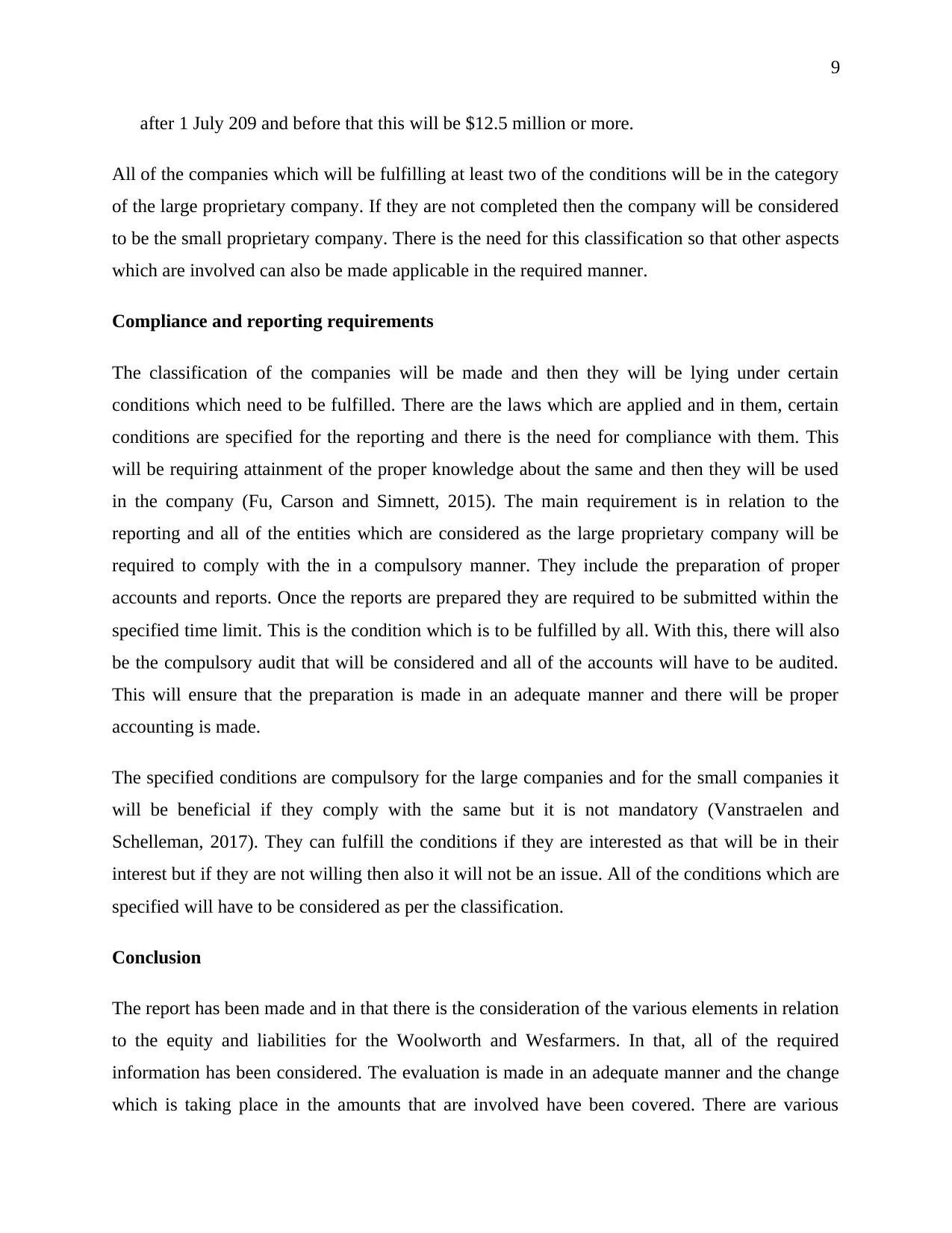
9
after 1 July 209 and before that this will be $12.5 million or more.
All of the companies which will be fulfilling at least two of the conditions will be in the category
of the large proprietary company. If they are not completed then the company will be considered
to be the small proprietary company. There is the need for this classification so that other aspects
which are involved can also be made applicable in the required manner.
Compliance and reporting requirements
The classification of the companies will be made and then they will be lying under certain
conditions which need to be fulfilled. There are the laws which are applied and in them, certain
conditions are specified for the reporting and there is the need for compliance with them. This
will be requiring attainment of the proper knowledge about the same and then they will be used
in the company (Fu, Carson and Simnett, 2015). The main requirement is in relation to the
reporting and all of the entities which are considered as the large proprietary company will be
required to comply with the in a compulsory manner. They include the preparation of proper
accounts and reports. Once the reports are prepared they are required to be submitted within the
specified time limit. This is the condition which is to be fulfilled by all. With this, there will also
be the compulsory audit that will be considered and all of the accounts will have to be audited.
This will ensure that the preparation is made in an adequate manner and there will be proper
accounting is made.
The specified conditions are compulsory for the large companies and for the small companies it
will be beneficial if they comply with the same but it is not mandatory (Vanstraelen and
Schelleman, 2017). They can fulfill the conditions if they are interested as that will be in their
interest but if they are not willing then also it will not be an issue. All of the conditions which are
specified will have to be considered as per the classification.
Conclusion
The report has been made and in that there is the consideration of the various elements in relation
to the equity and liabilities for the Woolworth and Wesfarmers. In that, all of the required
information has been considered. The evaluation is made in an adequate manner and the change
which is taking place in the amounts that are involved have been covered. There are various
after 1 July 209 and before that this will be $12.5 million or more.
All of the companies which will be fulfilling at least two of the conditions will be in the category
of the large proprietary company. If they are not completed then the company will be considered
to be the small proprietary company. There is the need for this classification so that other aspects
which are involved can also be made applicable in the required manner.
Compliance and reporting requirements
The classification of the companies will be made and then they will be lying under certain
conditions which need to be fulfilled. There are the laws which are applied and in them, certain
conditions are specified for the reporting and there is the need for compliance with them. This
will be requiring attainment of the proper knowledge about the same and then they will be used
in the company (Fu, Carson and Simnett, 2015). The main requirement is in relation to the
reporting and all of the entities which are considered as the large proprietary company will be
required to comply with the in a compulsory manner. They include the preparation of proper
accounts and reports. Once the reports are prepared they are required to be submitted within the
specified time limit. This is the condition which is to be fulfilled by all. With this, there will also
be the compulsory audit that will be considered and all of the accounts will have to be audited.
This will ensure that the preparation is made in an adequate manner and there will be proper
accounting is made.
The specified conditions are compulsory for the large companies and for the small companies it
will be beneficial if they comply with the same but it is not mandatory (Vanstraelen and
Schelleman, 2017). They can fulfill the conditions if they are interested as that will be in their
interest but if they are not willing then also it will not be an issue. All of the conditions which are
specified will have to be considered as per the classification.
Conclusion
The report has been made and in that there is the consideration of the various elements in relation
to the equity and liabilities for the Woolworth and Wesfarmers. In that, all of the required
information has been considered. The evaluation is made in an adequate manner and the change
which is taking place in the amounts that are involved have been covered. There are various
⊘ This is a preview!⊘
Do you want full access?
Subscribe today to unlock all pages.

Trusted by 1+ million students worldwide
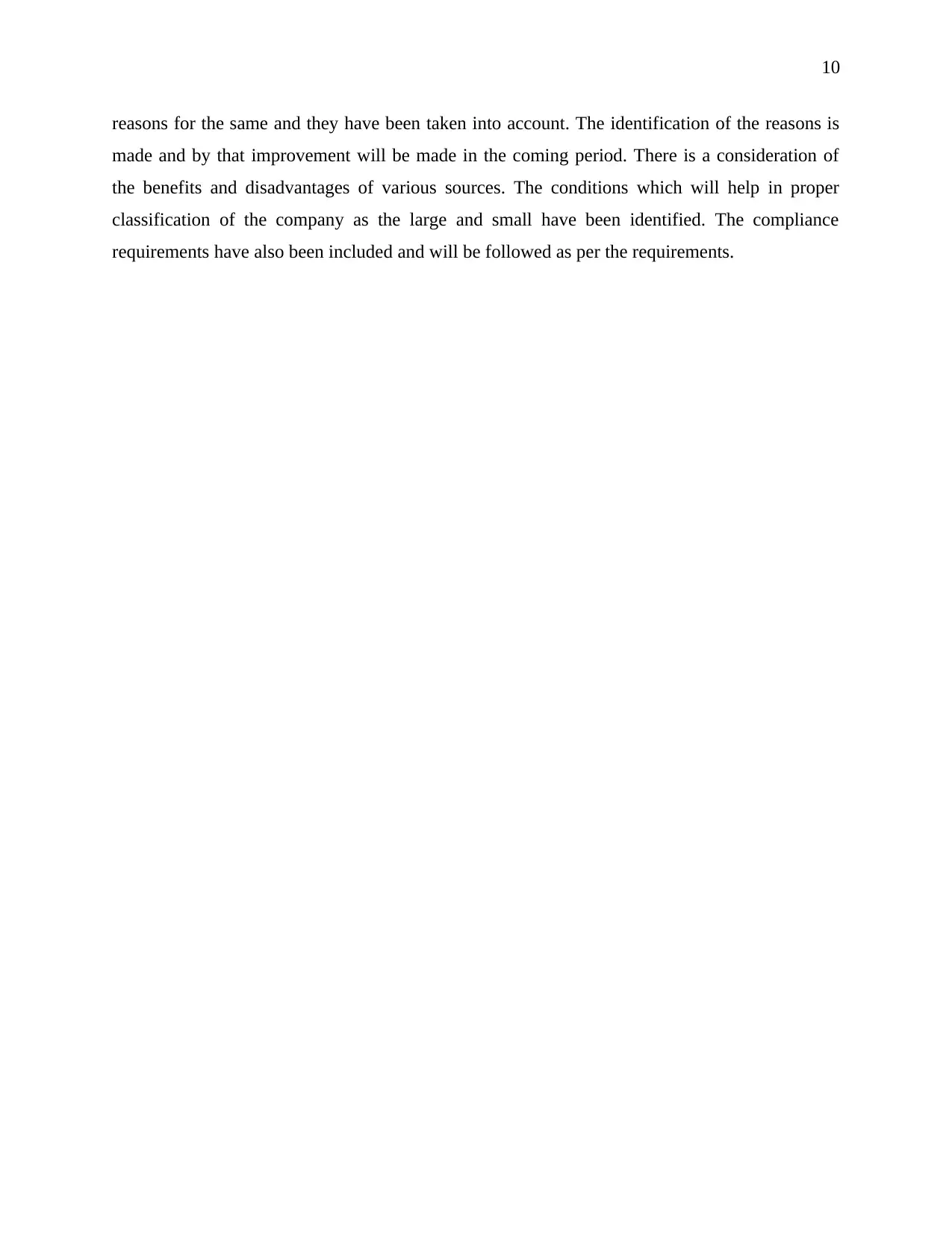
10
reasons for the same and they have been taken into account. The identification of the reasons is
made and by that improvement will be made in the coming period. There is a consideration of
the benefits and disadvantages of various sources. The conditions which will help in proper
classification of the company as the large and small have been identified. The compliance
requirements have also been included and will be followed as per the requirements.
reasons for the same and they have been taken into account. The identification of the reasons is
made and by that improvement will be made in the coming period. There is a consideration of
the benefits and disadvantages of various sources. The conditions which will help in proper
classification of the company as the large and small have been identified. The compliance
requirements have also been included and will be followed as per the requirements.
Paraphrase This Document
Need a fresh take? Get an instant paraphrase of this document with our AI Paraphraser
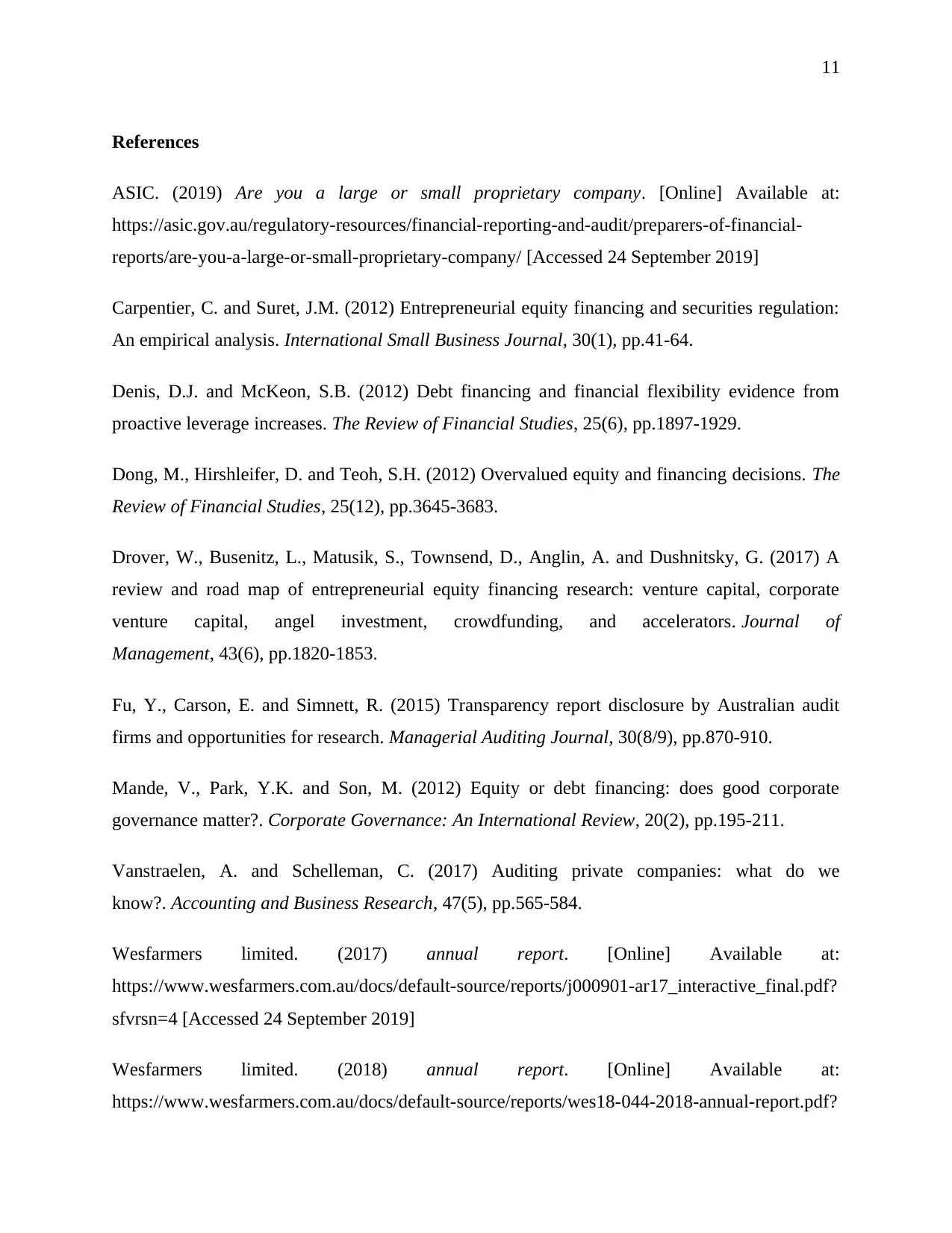
11
References
ASIC. (2019) Are you a large or small proprietary company. [Online] Available at:
https://asic.gov.au/regulatory-resources/financial-reporting-and-audit/preparers-of-financial-
reports/are-you-a-large-or-small-proprietary-company/ [Accessed 24 September 2019]
Carpentier, C. and Suret, J.M. (2012) Entrepreneurial equity financing and securities regulation:
An empirical analysis. International Small Business Journal, 30(1), pp.41-64.
Denis, D.J. and McKeon, S.B. (2012) Debt financing and financial flexibility evidence from
proactive leverage increases. The Review of Financial Studies, 25(6), pp.1897-1929.
Dong, M., Hirshleifer, D. and Teoh, S.H. (2012) Overvalued equity and financing decisions. The
Review of Financial Studies, 25(12), pp.3645-3683.
Drover, W., Busenitz, L., Matusik, S., Townsend, D., Anglin, A. and Dushnitsky, G. (2017) A
review and road map of entrepreneurial equity financing research: venture capital, corporate
venture capital, angel investment, crowdfunding, and accelerators. Journal of
Management, 43(6), pp.1820-1853.
Fu, Y., Carson, E. and Simnett, R. (2015) Transparency report disclosure by Australian audit
firms and opportunities for research. Managerial Auditing Journal, 30(8/9), pp.870-910.
Mande, V., Park, Y.K. and Son, M. (2012) Equity or debt financing: does good corporate
governance matter?. Corporate Governance: An International Review, 20(2), pp.195-211.
Vanstraelen, A. and Schelleman, C. (2017) Auditing private companies: what do we
know?. Accounting and Business Research, 47(5), pp.565-584.
Wesfarmers limited. (2017) annual report. [Online] Available at:
https://www.wesfarmers.com.au/docs/default-source/reports/j000901-ar17_interactive_final.pdf?
sfvrsn=4 [Accessed 24 September 2019]
Wesfarmers limited. (2018) annual report. [Online] Available at:
https://www.wesfarmers.com.au/docs/default-source/reports/wes18-044-2018-annual-report.pdf?
References
ASIC. (2019) Are you a large or small proprietary company. [Online] Available at:
https://asic.gov.au/regulatory-resources/financial-reporting-and-audit/preparers-of-financial-
reports/are-you-a-large-or-small-proprietary-company/ [Accessed 24 September 2019]
Carpentier, C. and Suret, J.M. (2012) Entrepreneurial equity financing and securities regulation:
An empirical analysis. International Small Business Journal, 30(1), pp.41-64.
Denis, D.J. and McKeon, S.B. (2012) Debt financing and financial flexibility evidence from
proactive leverage increases. The Review of Financial Studies, 25(6), pp.1897-1929.
Dong, M., Hirshleifer, D. and Teoh, S.H. (2012) Overvalued equity and financing decisions. The
Review of Financial Studies, 25(12), pp.3645-3683.
Drover, W., Busenitz, L., Matusik, S., Townsend, D., Anglin, A. and Dushnitsky, G. (2017) A
review and road map of entrepreneurial equity financing research: venture capital, corporate
venture capital, angel investment, crowdfunding, and accelerators. Journal of
Management, 43(6), pp.1820-1853.
Fu, Y., Carson, E. and Simnett, R. (2015) Transparency report disclosure by Australian audit
firms and opportunities for research. Managerial Auditing Journal, 30(8/9), pp.870-910.
Mande, V., Park, Y.K. and Son, M. (2012) Equity or debt financing: does good corporate
governance matter?. Corporate Governance: An International Review, 20(2), pp.195-211.
Vanstraelen, A. and Schelleman, C. (2017) Auditing private companies: what do we
know?. Accounting and Business Research, 47(5), pp.565-584.
Wesfarmers limited. (2017) annual report. [Online] Available at:
https://www.wesfarmers.com.au/docs/default-source/reports/j000901-ar17_interactive_final.pdf?
sfvrsn=4 [Accessed 24 September 2019]
Wesfarmers limited. (2018) annual report. [Online] Available at:
https://www.wesfarmers.com.au/docs/default-source/reports/wes18-044-2018-annual-report.pdf?
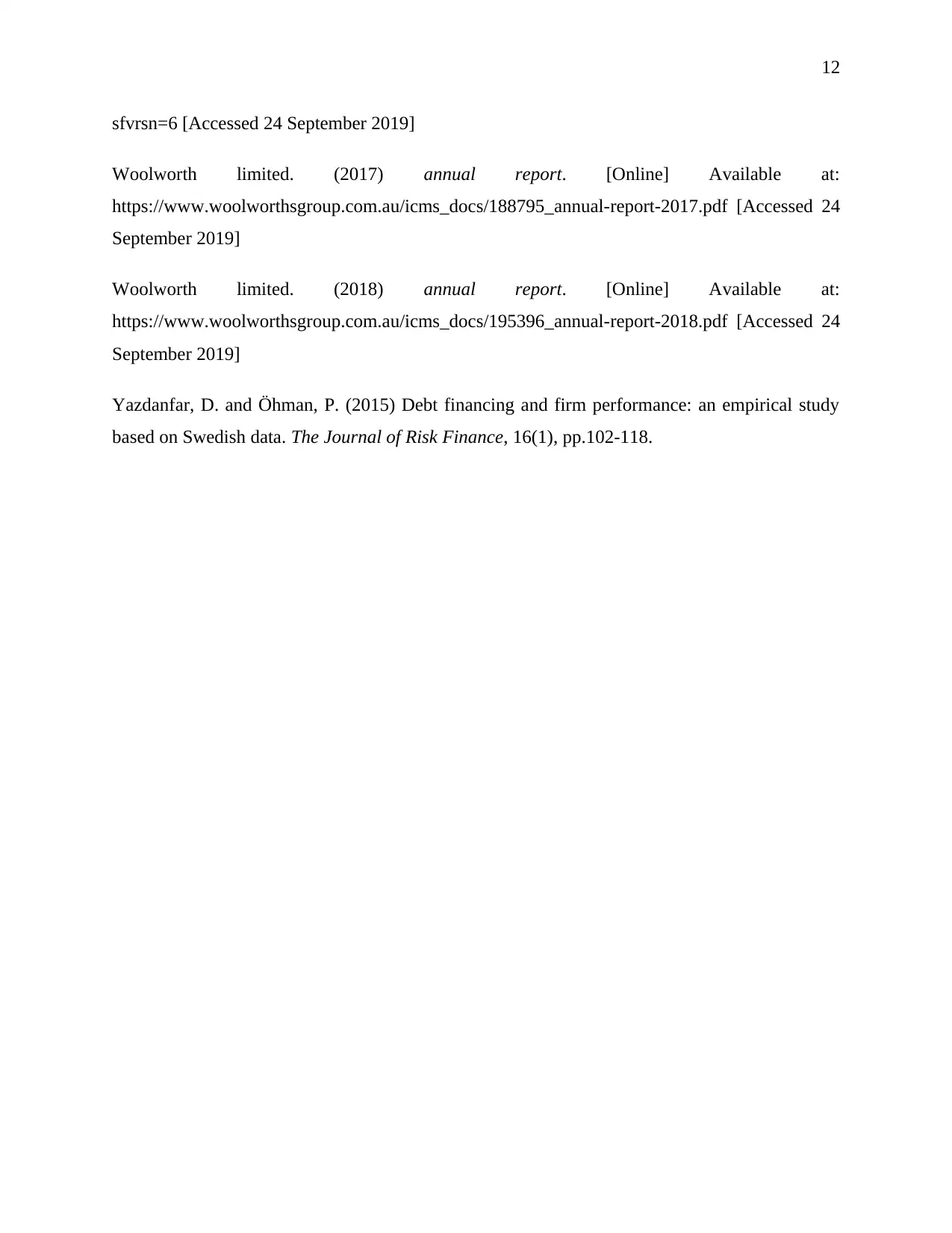
12
sfvrsn=6 [Accessed 24 September 2019]
Woolworth limited. (2017) annual report. [Online] Available at:
https://www.woolworthsgroup.com.au/icms_docs/188795_annual-report-2017.pdf [Accessed 24
September 2019]
Woolworth limited. (2018) annual report. [Online] Available at:
https://www.woolworthsgroup.com.au/icms_docs/195396_annual-report-2018.pdf [Accessed 24
September 2019]
Yazdanfar, D. and Öhman, P. (2015) Debt financing and firm performance: an empirical study
based on Swedish data. The Journal of Risk Finance, 16(1), pp.102-118.
sfvrsn=6 [Accessed 24 September 2019]
Woolworth limited. (2017) annual report. [Online] Available at:
https://www.woolworthsgroup.com.au/icms_docs/188795_annual-report-2017.pdf [Accessed 24
September 2019]
Woolworth limited. (2018) annual report. [Online] Available at:
https://www.woolworthsgroup.com.au/icms_docs/195396_annual-report-2018.pdf [Accessed 24
September 2019]
Yazdanfar, D. and Öhman, P. (2015) Debt financing and firm performance: an empirical study
based on Swedish data. The Journal of Risk Finance, 16(1), pp.102-118.
⊘ This is a preview!⊘
Do you want full access?
Subscribe today to unlock all pages.

Trusted by 1+ million students worldwide
1 out of 12
Related Documents
Your All-in-One AI-Powered Toolkit for Academic Success.
+13062052269
info@desklib.com
Available 24*7 on WhatsApp / Email
![[object Object]](/_next/static/media/star-bottom.7253800d.svg)
Unlock your academic potential
Copyright © 2020–2025 A2Z Services. All Rights Reserved. Developed and managed by ZUCOL.





